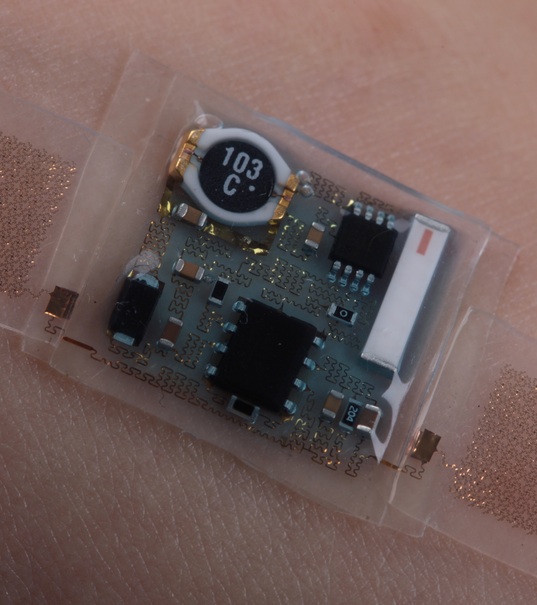 Researchers at University of Illinois at Urbana-Champaign and Northwestern University are continuing to iterate in the field of stretchable, flexible sensors and antennae. A new paper, recently published in Science, presented a new approach to the category that would allow off-the-shelf chip-based electronics to be incorporated into a peel-and-stick patch.
Researchers at University of Illinois at Urbana-Champaign and Northwestern University are continuing to iterate in the field of stretchable, flexible sensors and antennae. A new paper, recently published in Science, presented a new approach to the category that would allow off-the-shelf chip-based electronics to be incorporated into a peel-and-stick patch.
“We designed this device to monitor human health 24/7, but without interfering with a person’s daily activity,” Yonggang Huang, the Northwestern University professor who co-led the work with Illinois professor John Rogers, said in a statement. “It is as soft as human skin and can move with your body, but at the same time it has many different monitoring functions. What is very important about this device is it is wirelessly powered and can send high-quality data about the human body to a computer, in real time.”
The key innovation in the science paper is that the chips are suspended in a thin layer of fluid within an elastic envelope. This allows stretchable implementation of existing chips, whereas in previous efforts researchers had to specially construct sensors and antennae. Specially designed "oragami-folded" wires connected the chips to one another within the patch. In their research, engineers incorporated EEG, ECG, and motion sensors into the technology.
"Our original concepts involved specialized, ultrathin device geometries in an open mesh layout with a thin, soft membrane support," Rogers told MobiHealthNews in an email. "... The technical challenge, from practical standpoint, is that the thin layouts require, in many cases, custom device designs, much different than those found in the commercial sector today. In other cases, the relevant components, e.g. chip-scale batteries, large capacitors, might not ever be available in thin forms. The new work avoids these constraints, to open up options for using largely conventional electronic, sensor, radio and battery components."
Researchers found that the stretchable sensors performed equally well to traditional EKG and EEG sensors, while providing more comfort to patients in a small side-by-side comparison. The technology has a number of possibly applications increasing the comfort and accuracy of activity trackers or patient monitoring devices. In particular, areas like sleep monitoring, where discomfort can effect the quality of readings, could benefit.
The technology will be commercialized eventually through the company Rogers co-founded, Cambridge, Massachusetts-based MC10.
"The Checklight product (Gen 1) that they released last year with Reebok is the first step on a roadmap that takes them to full epidermal designs," he said. "Their Gen 2 will be ready next year. Gen 3 will be very close to truly epidermal, likely available the year after. Many applications are being pursued, ranging from sports/fitness, to skin care/cosmetics, to continuous health/wellness to clinical-quality monitoring in the home, and others."
Rogers and Huang are one of two groups of researchers making headlines recently with stretchable, flexible electronics. The other, a team from North Carolina State University led by Yong Zhu, recently published a paper in Applied Materials and Interfaces about their own stretchable antennae, which use silver nanowires to achieve an effect similar to Rogers' team's original design.
Rogers said the work his team has done on the original technology isn't in vain, as it still offers some advantages over the microfluidic design.
"Future epidermal devices will likely combine the original ultrathin concepts with the microfluidic/origami ideas, to expand the functional options, reduce the costs, and speed the realization of commercial devices," he said.
















